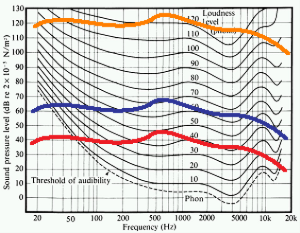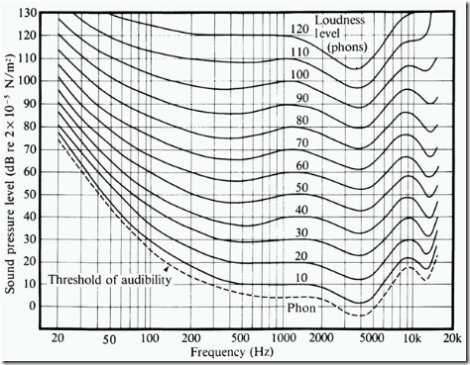Louder Sounds Better
Below is an example of the Fletcher-Munson Equal Loudness Curve. It is one of the most recognized graphics in audio engineering.
The horizontal axis is frequency of tones, and the vertical axis is actual sound pressure in dBSPL. Each point on a curve has about the same subjective "loudness" to the human ear. The low parts of the curves are the frequencies where the ear is more sensitive. Conversely, the high parts are where the ear is less sensitive and it takes more pressure to get the same 'loudness'. The dotted line at the bottom represents the threshold of hearing. Any frequency below that line can't be heard at all by the average human.
 Consider an arbitrary waveform coming out of a speaker. That waveform has the frequency response shown in red on the diagram to the right. The blue line is the same waveform amplified by 20dB, and the orange line is amplified by 80dB. Notice that the louder signal aligns better with the flatter Fletcher-Munson curves at the top. There is less variation in sound at different frequencies, and the result is that the louder signal has a richer, fuller sound.
Consider an arbitrary waveform coming out of a speaker. That waveform has the frequency response shown in red on the diagram to the right. The blue line is the same waveform amplified by 20dB, and the orange line is amplified by 80dB. Notice that the louder signal aligns better with the flatter Fletcher-Munson curves at the top. There is less variation in sound at different frequencies, and the result is that the louder signal has a richer, fuller sound.
The opposite is also true. For quieter sounds, certain frequencies to which the ear is less-sensitive can seem to drop out of the signal, especially at very high and very low frequencies. The orange line has a very powerful bass, with low frequencies staying close to the same loudness as the middle. The blue line's bass is much less 'loud' than the middle frequencies. Many frequencies on the red line have completely dropped out, below the threshold of hearing.
The Fletcher-Munson curves illustrate an audio engineering example of why, to the human ear, louder sounds better. The higher the signal amplitude, the more frequencies are present, making the signal richer and fuller. You can also read this article, which discusses it from an audio production and musician's point of view.
A practical result of this is that when a person tries to compare two sounds, the louder one will often subjectively sound better regardless of their relative signal quality. Any time you want to compare sounds by ear objectively, you have to make sure they're the same level.
One final note: I hope this post does a little bit to explain why people are drawn to loud concerts, or to turning headphones up to extremely high levels, but there's a very dangerous flip-side. The orange line in my figure above peaks out at about 125dBSPL. A concert at that level may indeed sound good, but it is also at or above the threshold of pain, depending on the listener, and any prolonged exposure will likely cause permanent hearing damage. There are any number of guidelines about maximum safe listening levels, and I recommend you heed them. That set of headphones may sound mighty fine cranked up to 90dBSPL, but they are also doing irreparable damage to one of your most important and finely tuned sensory organs. Perhaps someday I'll do a post on exactly what happens when you destroy your auditory receptors. Trust me, it isn't fun.
Comments
- Anonymous
February 07, 2007
Aside from the distortion artifacts, one of the biggest problems that results from clipping is a loss - Anonymous
September 27, 2007
i can not cnn, bbc, or fm staitions because ,the video does not play and the radio plays there is no sound
